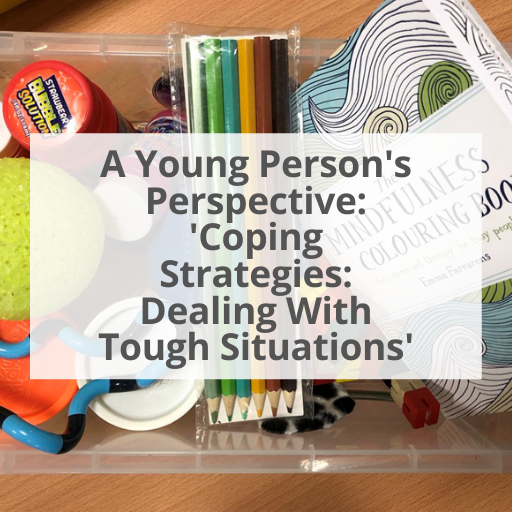17th Dec 2021
A Young Person’s Perspective: ‘Coping Strategies: Dealing With Tough Situations’

A young person, who has been through our services, has produced this blog post to provide you with some tips and tricks he has found useful for coping with tough situations. These coping strategies are his own experience, and whilst they may be inspired by his time with Care in Mind, they are also unique to what he has personally found useful.
Here are their tips, in five separate categories, based on different ways to cope:
Coping strategies can come in many different forms and are useful for different people.
Part 1: Sensory Coping strategies:
There are two main sensory ways to help: one is via a sensory box and the other is creating a space that appeals to your sensory needs.
To create a sensory box you need to find items that appeal to your senses, this could be any of the senses you have. One way is to use something called a sensory hand. This is where you grab a piece of paper and draw around your own hand and each finger can be a sense. Write down next to each finger what you like with each sense for example: for your sense of smell it could be coffee, perfume, item of clothing or even a new item that has that classic “new item smell”.

A space that appeals to your sensory needs means items that help you relax can be put in a certain room (a snug, bedroom, living room) where you can go to relax. This could include LED lights, noise boxes, incense, candles, blankets.
Part 2: distractions
Distractions are for when you don’t feel like you can face the emotion, there are many different ways to distract yourself. Some examples are:
- playing games
- playing with or having your pet around you (if it wants to snuggle or play)
- playing music that allows you to think differently or move your mind to a different thought
- watching films or tv shows that will also distract you can be brilliant
- going on walks can help due to focusing on the outside, try to recognise what’s around you and the beauty of it all;
- photography can distract you because you are looking for the right angles, lighting, background etc.

Part 3: Facing the emotion head-on
The best way to deal with emotions is to deal with them as they come up so they don’t build up subconsciously and return. Here, we will share six steps for dealing with a specific situation – my friend didn’t come to meet me and didn’t apologise.
- Be aware of how you feel and the emotion you are feeling. Trying to know what the emotion is and why it is there will best help you on a way to deal with it. For example “I’m so angry that my friend didn’t come to meet me and didn’t apologise.” Here, the dominant emotion is anger.
- Remember not to start blaming when recognising an emotion. What we are trying to do is understand it, your friend isn’t trying to hurt you by not coming to see you. There are a variety of reasons why we may feel we need to blame, but at the moment we are trying to recognise and understand the emotion.
- Understand that it is okay to feel that way about a situation. Everyone copes with emotions differently and it’s okay to feel the way you feel in whatever situation.
- Think of the most positive way to deal with this emotion. For this there are ways to do so, such as communicating calmly with your friend that you feel hurt by their actions.
- Remember to talk to someone about it, even if you feel it has been dealt with. This allows you to discuss different options for the future and evaluate what to do if a similar situation occurs again. This could be your parent or guardian, trusted adult, friend, or a healthcare professional. Sometimes even talking to your pet can help, just to get it out.
- Finally, it’s okay to cry.
Part 4: Exercise for different emotional states
If you feel a certain emotion you may feel that a certain exercise can help, here are a few which we could recommend:
- Angry: High impact exercises like boxing, sprints, interval training with a bike or other cardio tools
- Sad: Low impact like walking, casual cycling or anything that isn’t strenuous
- Anxious: Calming exercises like yoga, Tai Chi or swimming
Part 5: Find a creative outlet
Sometimes finding a creative outlet to funnel your emotions is useful, but it can also be a good distraction technique. There are many ways you can be creative, such as:
- Painting, drawing or crafts
- Creating or producing music
- Writing lyrics, poems or stories
- Writing how you feel in a journal

There are lots of different ways to cope with tough situations, from facing them head-on to using distraction techniques. We hope our tips will help you if you are facing your own difficulties!
To make a referral or to find out more information about our services, please call the team on 0161 638 3285 or email referrals@careinmind.com

